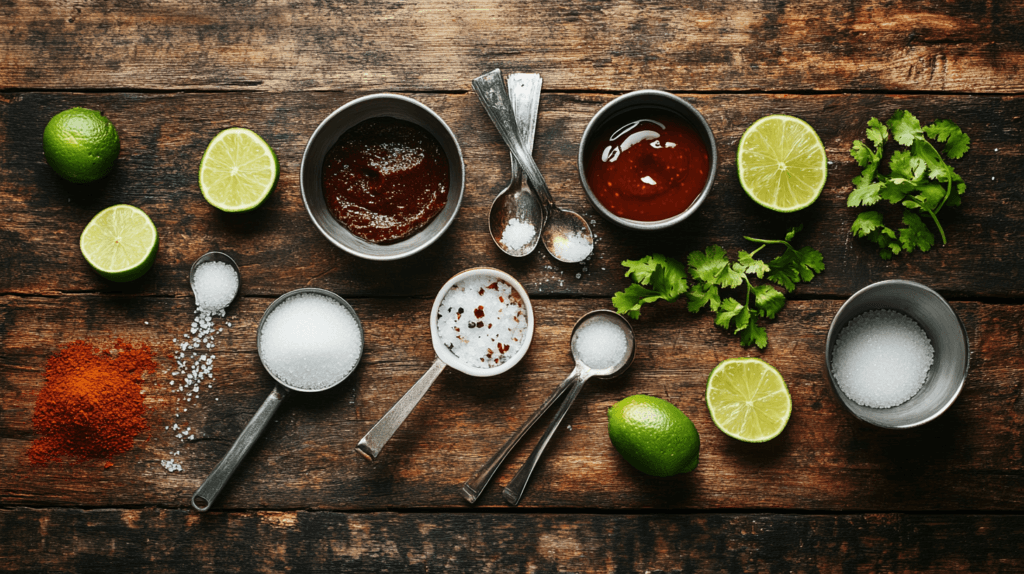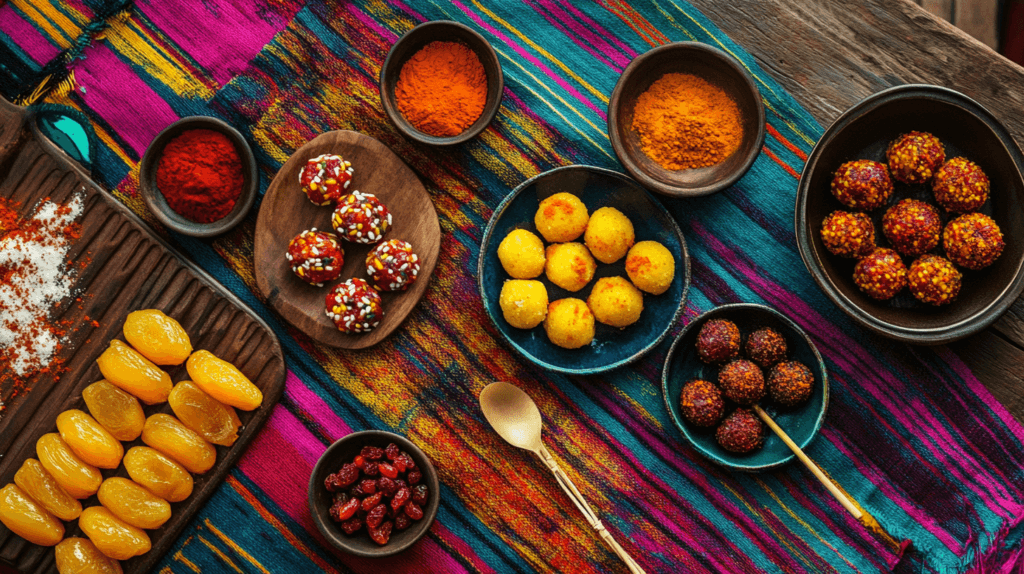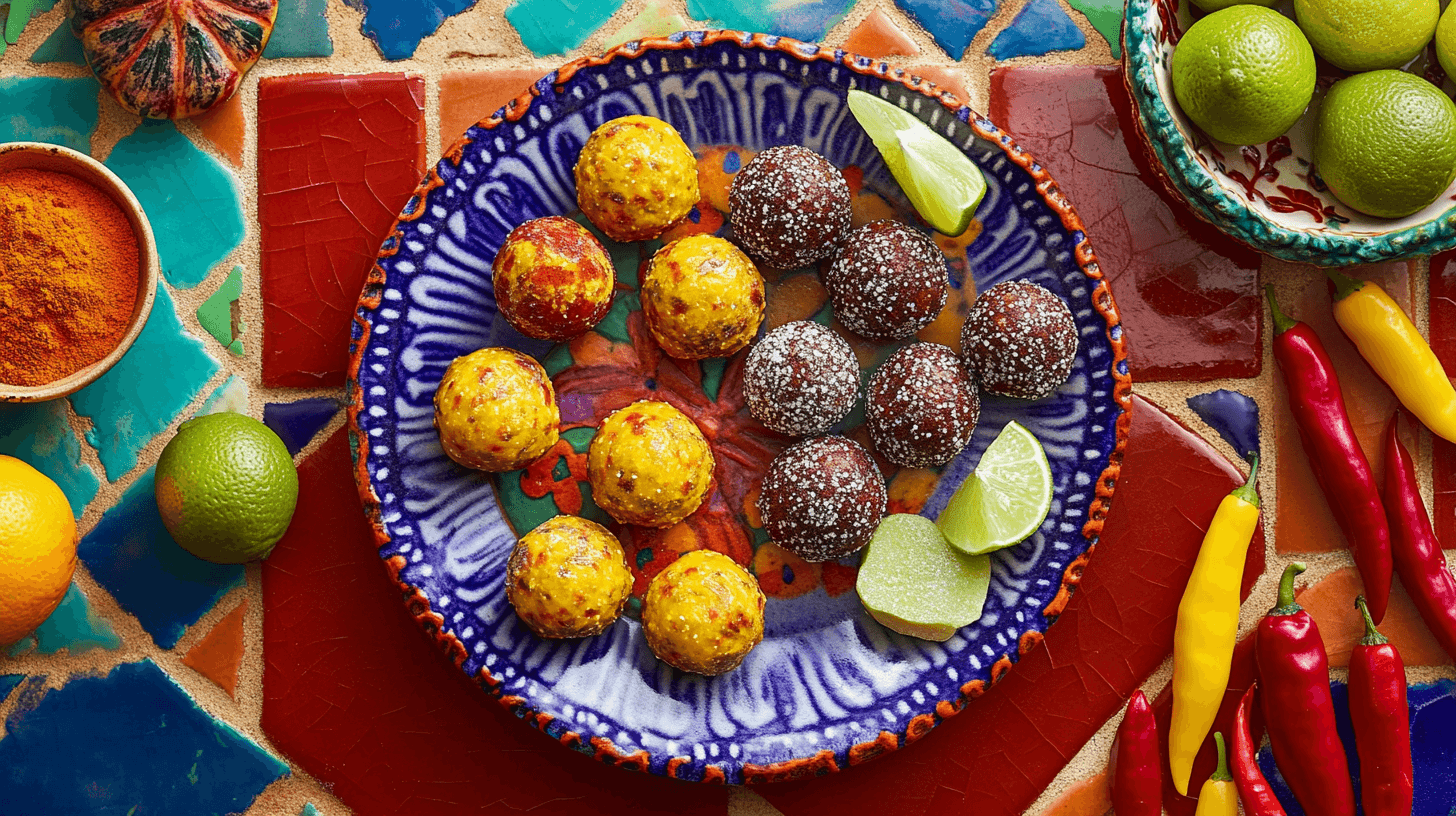Introduction
Mexican candy is a fascinating blend of flavors that beautifully brings together the perfect harmony of sweet, spicy, and tangy elements. These delightful treats are not just simple confections; rather, they represent a cultural expression of Mexico’s rich culinary artistry. Furthermore, every bite offers a vibrant taste of tradition, making these candies an integral part of celebrations and everyday life.
Whether enjoyed during lively festivals, sold by bustling street vendors, or lovingly shared as thoughtful gifts, Mexican candies undoubtedly hold a special place in the hearts of many. For example, the bold tang of tamarind combined with the fiery kick of chili powder creates a flavor that caters to every palate. Additionally, these sweets offer an irresistible combination of bold flavors. Most importantly, the simplicity of making them at home makes it an inviting activity for families and food enthusiasts alike.
In this guide, we’ll walk you through everything you need to know about crafting a Mexican candy: easy recipe for a sweet and tangy treat. Ultimately, by the time you finish, you’ll not only have a delicious treat to share but also a deeper appreciation for the rich traditions behind these iconic sweets.
What Makes Mexican Candy Easy to Prepare and Unique?
Mexican candy is widely celebrated for its unique interplay of flavors, which truly sets it apart from most other cuisines. In contrast to Western candies, which often focus solely on sweetness, Mexican candies masterfully combine sweet, sour, and spicy notes to create an unforgettable taste experience. Furthermore, this distinct combination not only highlights bold flavor contrasts but also showcases the creativity and diversity deeply rooted in Mexican culture. As a result, these candies offer a unique culinary experience that delights both the taste buds and the soul.
Cultural Significance of Mexican Candy
These candies are more than just snacks—they are deeply rooted in Mexican traditions and festivals. For instance, dulces de tamarindo are often served during family gatherings, while candies like chamoy covered mango slices are staples of Mexican street food culture. Each candy tells a story, representing the flavors and ingredients native to the region. This cultural importance makes them a cherished part of Mexican heritage, bringing people together through their shared love for bold flavors.
Varieties of Mexican Candy
The variety of Mexican candy is truly remarkable, and, more importantly, understanding the different types can easily inspire your own creations. Additionally, the sheer range of flavors and textures found in these candies provides endless opportunities for experimentation. Consequently, exploring these varieties not only enhances your appreciation for Mexican sweets but also encourages you to try crafting unique treats tailored to your taste.
- Tamarind-Based Candies: These are tangy, sticky treats often rolled in sugar and chili powder.
- Chamoy Treats: Chamoy adds a tart, fermented fruit flavor to candies, making them uniquely tangy.
- Spicy Mango Candies: These combine the sweetness of mango with a fiery chili powder coating.
- Traditional Street Treats: Items like Pulparindo and Pelon Pelo Rico are beloved staples of Mexican candy shops.
By experimenting with these different varieties, you can effortlessly bring an authentic touch to your homemade creations. Furthermore, trying out various ingredients and techniques allows you to personalize each recipe to suit your preferences. As a result, you not only enjoy the flavors of traditional Mexican candy but also add your own creative twist, making the experience even more rewarding.

Ingredients You’ll Need for Mexican Candy
The beauty of making Mexican candy lies in its simplicity. With just a handful of ingredients and basic tools, you can recreate these traditional treats in your kitchen. Using high quality ingredients ensures the best flavor and texture, making your candies truly exceptional.
Essential Ingredients
To get started, gather the following staples:
- Tamarind Paste: The tangy base for most Mexican candies.
- Sugar: Provides sweetness and balances the tartness.
- Chili Powder: Adds a spicy kick; Tajín is highly recommended for authenticity.
- Chamoy Sauce: A fermented fruit sauce that lends tanginess.
- Lime Juice: Enhances the tart flavor and adds freshness.
- Salt: A pinch of salt heightens all the other flavors.
Optional Add-Ins
- Mango Puree: Ideal for creating fruity candies.
- Honey or Corn Syrup: Used for achieving a softer texture.
- Dried Fruits: Apricots, plums, or raisins can add depth to the flavor.
Tools Needed
Having the right tools can simplify the candy making process. You’ll need:
- A saucepan for cooking the candy mixture.
- A wooden spoon for stirring.
- Candy molds or a baking sheet lined with parchment paper.
- Airtight containers for storing the finished candies.
With these ingredients and tools on hand, you’re fully prepared to begin creating your very own Mexican candy masterpiece. Additionally, having everything readily available ensures a smoother and more enjoyable cooking process. As you start experimenting, you’ll find that these simple yet flavorful recipes can easily become a delightful addition to your culinary repertoire.

Step-by-Step Recipe: Mexican Candy Made Easy
Crafting Mexican candy at home is not only a fun and rewarding experience but also a creative way to explore bold flavors. By following this detailed recipe, you can easily create an authentic treat that perfectly captures the signature sweet, spicy, and tangy flavors. Moreover, each step is carefully designed to simplify the process while ensuring consistently great results. As you work through the recipe, you’ll discover just how enjoyable and satisfying it is to make these iconic sweets from scratch.
Ingredients for Tamarind Candy
- 1 cup tamarind paste
- 1 cup granulated sugar
- 1 tablespoon chili powder
- ½ teaspoon salt
- 1 tablespoon lime juice
Instructions
- Prepare the Tamarind Paste: Start by softening the tamarind paste. If you’re using tamarind pods, soak them in warm water and remove the seeds. For convenience, store bought paste works just as well.
- Mix Ingredients in a Saucepan: Combine tamarind paste, sugar, chili powder, salt, and lime juice in a saucepan. Mix thoroughly.
- Cook the Mixture: Heat over medium heat, stirring constantly until the mixture thickens to a dough like consistency. Be careful not to overcook, as this can harden the candy.
- Shape the Candies: Allow the mixture to cool slightly. Use your hands to roll the mixture into small balls or press it into candy molds for fun shapes.
- Add Final Touches: Roll each candy ball in a mix of sugar and chili powder for an extra burst of flavor.
Pro Tips for Success
- For a softer candy, cook the mixture for a shorter time.
- Adjust the chili powder based on your preferred spice level.
- For a glossy finish, lightly brush the candies with chamoy sauce before serving.
By carefully following these steps, you’ll quickly create a batch of tamarind candies that not only captures the authentic flavors but also rivals those found in bustling Mexican markets. Furthermore, the homemade touch adds a sense of pride and personalization to your treats, making them even more special to share with family and friends. As a result, you’ll find that these candies become a cherished addition to your recipe collection.

Variations of Mexican Candy to Try
One of the greatest things about Mexican candy is its incredible adaptability. In fact, by simply tweaking the basic recipe, you can effortlessly create endless variations to suit your unique tastes or meet specific dietary needs. Additionally, this versatility ensures that there’s a version of Mexican candy for everyone, whether you prefer fruity, spicy, or tangy flavors. As a result, these treats can be customized for any occasion, making them a truly versatile addition to your dessert repertoire.
Mango Chamoy Candy
- Replace tamarind paste with mango puree for a fruity twist.
- Add chamoy for a tangy finish.
Spicy Tamarind Lollipops
- Roll the tamarind mixture around lollipop sticks.
- Sprinkle with extra chili powder for a bold flavor.
Vegan and Gluten-Free Options
- Use plant based sweeteners like agave syrup.
- Avoid any gluten containing additives in store bought chamoy.
Sugar-Free Candy
- Substitute sugar with a low calorie sweetener such as erythritol.
- Adjust the recipe to balance sweetness with the tangy tamarind flavor.
These variations not only allow you to customize your candies for different occasions and dietary preferences but also enhance their versatility. Furthermore, adapting the recipes ensures that everyone, regardless of their tastes or restrictions, can enjoy these delightful treats. As a result, you can easily create candies that are perfect for parties, gifting, or simply satisfying your sweet tooth in a unique way.
Serving and Pairing Suggestions
Mexican candy is absolutely perfect for any occasion, whether you’re hosting a lively party, celebrating a special event, or simply craving a sweet snack to brighten your day. Moreover, it pairs beautifully with other dishes, adding an exciting and unexpected flavor contrast that elevates your culinary experience. As a result, these versatile treats can seamlessly complement savory meals or stand out as the centerpiece of a dessert platter.
- Serve as a snack at parties or family gatherings.
- Pair with savory dishes like creamy enchiladas to create a balanced meal.
- Add to dessert platters alongside fresh fruit and nuts.
By pairing Mexican candy with complementary foods, you can elevate your culinary presentation and delight your guests.
Nutritional Information and Health Considerations
Homemade Mexican candy is not only delicious but also offers a healthier alternative to store bought sweets. By controlling the ingredients, you can make adjustments to suit your health goals.
Nutritional Highlights
- Calories: Approximately 50-70 per candy piece.
- Vitamins: Tamarind is rich in vitamin C and antioxidants.
- Potassium: Mango and tamarind are excellent sources of this vital nutrient.
Health Tips
- For a lower calorie option, reduce the sugar or use a natural sweetener.
- Opt for gluten-free tamarind paste and chili powder for dietary restrictions.
These adjustments allow you to enjoy your favorite treats without compromising on health.
Storing and Preserving Mexican Candy Easy Recipe
Proper storage is key to maintaining the freshness and flavor of your homemade candies. Follow these tips to preserve them effectively:
- Room Temperature: Store in airtight containers for up to one week.
- Refrigeration: Extend shelf life to two weeks by refrigerating.
- Freezing: For long-term storage, freeze candies in a sealed container for up to three months.
When ready to serve, let frozen candies thaw at room temperature for optimal texture.
FAQs About Mexican Candy Easy Recipe
Can you eat potatoes at Passover?
Yes, potatoes are allowed during Passover and are often used in many traditional dishes. They are a flexible and kosher option for Passover that takes the place of leavened foods, which are not allowed during the holiday. Dishes like potato kugel or Passover potato pie show how important potatoes are in holiday meals.
What is one of the symbolic foods eaten during the Passover Seder?
One of the key symbolic foods is matzo (unleavened bread), which stands for the haste with which the Israelites left Egypt. Other symbolic foods include bitter herbs to remind us of the hardship of slavery and charoset, a sweet mixture that represents the mortar used in forced labor.
What are the 5 forbidden foods on Passover?
During Passover, Jews avoid foods made from the five grains that can ferment and become leavened (chametz). These are:
Wheat
Barley
Oats
Rye
Spelt
Additionally, many avoid legumes, rice, and corn (kitniyot) depending on their tradition.
Why are potatoes not kosher?
Potatoes themselves are kosher and are even widely used during Passover. However, they might become non kosher if prepared with ingredients or methods that violate kosher laws. For example, using non kosher oil or mixing them with forbidden foods would render them unsuitable. Always ensure proper preparation to maintain kosher standards.
Conclusion
Mexican candy is more than just a treat—it’s a celebration of flavor and culture. By following this Mexican candy: easy recipe for a sweet and tangy treat, you can bring the authentic taste of Mexico to your kitchen. Whether you’re making them for yourself or sharing them with loved ones, these candies are sure to impress.
For more delightful recipes, try another homemade candy with this easy peanut brittle recipe without corn syrup or discover authentic Mexican flavors with this comforting caldo de pollo recipe.

